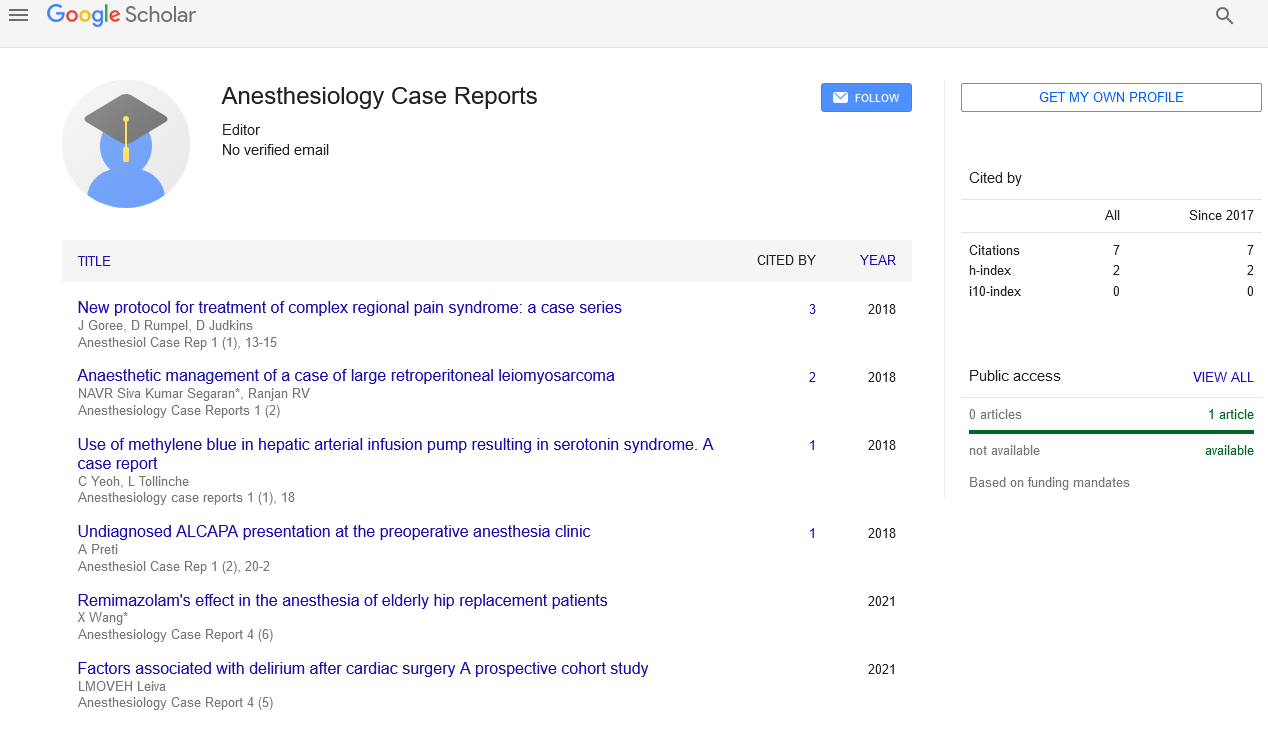Assessment of heart rate recovery during submaximal exercise testing for the purpose of predicting postoperative cardiopulmonary problems
Received: 11-Jun-2023, Manuscript No. pulacr-23-6480; Editor assigned: 14-Jun-2023, Pre QC No. pulacr-23-6480 (PQ); Accepted Date: Jun 26, 2023; Reviewed: 21-Jun-2023 QC No. pulacr-23-6480 (Q); Revised: 24-Jun-2023, Manuscript No. pulacr-23-6480 (R); Published: 28-Jun-2023
Citation: Rashid O. Assessment of heart rate recovery during submaximal exercise testing for the purpose of predicting postoperative cardiopulmonary problems. Anesthesiol: Case Rep. 2023; 6(3):3-4.
This open-access article is distributed under the terms of the Creative Commons Attribution Non-Commercial License (CC BY-NC) (http://creativecommons.org/licenses/by-nc/4.0/), which permits reuse, distribution and reproduction of the article, provided that the original work is properly cited and the reuse is restricted to noncommercial purposes. For commercial reuse, contact reprints@pulsus.com
Abstract
A crucial aspect of perioperative medicine is risk prediction. The gold standard, objective test of cardiopulmonary fitness is cardiopulmonary exercise testing at maximum exertion. Its availability, expense, and contraindications for people with specific comorbidities all limit its use. Tests of submaximal exercise, such as the 6-minute walk test, provide an affordable, well-tolerated alternative, but patient effort can affect the results. Its availability, expense, and contraindications for people with specific comorbidities all limit its use. Heart rate recovery-area under the curve, a new heart rate recovery measurement metric that we developed, outperforms existing markers across a range of exercise intensities in healthy volunteers in terms of repeatability and effort dependence.
Key Words
heart rate; submaximal exercise
Introduction
HRR-AUC's relevance in the surgical population is still uncertain, though. In patients following lung resection surgery, we intended to investigate the relationship between established (heart rate recovery 1, 6MWT distance) and novel (HRR-AUC) quantifiers of functional capacity with cardiopulmonary problems and length of High Dependency Unit (HDU) stay [1]. A multicenter, prospective, observational cohort study recruiting patients presenting for lung cancer resection, the BNP for Prediction of Outcome Following Lung Resection Surgery (PROFILES) project, collected data that we expected to analyse later [2]. The BNP for Prediction of Outcome Following Lung Resection Surgery (PROFILES) trial, a multicenter prospective observational cohort study recruiting patients presenting for lung cancer resection, obtained data that we expected to analyse later. We looked back on a subgroup of patients who had heart rate recovery assessment after 6MWTs during pre-operative surgical assessment between October 2018 and August 2019. The American Thoracic Society's recommendations for the 6MWTs were changed to include heart rate recovery determination. A portable ECG monitor (Avant 4000, NoninMedical, Plymouth, MN, USA) was used to record heart rate at 30-second intervals for six minutes following the end of exercise [3]. Heart rate vs. time curves were then generated using the data. The composite trapezoid rule was used to compute the area under the heart rate vs. time curve during the course of the 6min recovery period, or HRR-AUC. The main result was the relationship between heart rate recovery 1, HRR-AUC, distance covered at 6MWT, and cardiopulmonary problems 30 days following surgery as per the definitions in the "Silver-book" of the European Society of Thoracic Surgeons [4]. A secondary outcome was the length of HDU stay, with a protracted stay defined as lasting more than 24 hours postoperatively.
The Student's t-test was used to assess the mean heart rate recovery 1, HRR-AUC, and 6MWT distance between patients with and without cardiopulmonary problems and lengthy HDU stays. To investigate the prediction potency of the 6MWT distance, heart rate recovery 1, and HRR-AUC for cardiopulmonary problems, Area under the Receiver Operating Characteristic Curves (AUROCCs) were determined [5].
For the 6MWT and heart rate recovery tests, the PROFILES study enrolled a subgroup of 36 patients, 29 of whom provided complete data for analysis. Ten (or 34%) patients experienced cardiopulmonary issues.
In conclusion, our research indicates that, in comparison to the 6MWT and heart rate recovery 1 in patients undergoing lung resection surgery, pre-operative HRR-AUC significantly differs in patients with cardiopulmonary complications and exhibits predictive capability for 30-day cardiopulmonary complications. A promising replacement for existing pre-operative fitness predictors is provided by the HRR-AUC [5]. To evaluate the HRR-AUC's predictive power in clinical practise with other validated risk assessment tools, such as the Duke Activity Status Index, a larger, multicenter trial is required.
References
- Smith I, Kranke P, Murat I, et sl. Perioperative fasting in adults and children: guidelines from the European Society of Anaesthesiology. Eur J Anaesthesiol. 2011 ;28(8):556-69.
- Jayaram A, Bowen MP, Deshpande S, et al. Ultrasound examination of the stomach contents of women in the postpartum period. Anesth Analg. 1997;84(3):522-6.
- Perlas A, Chan VW, Lupu CM, et al. Ultrasound assessment of gastric content and volume. J Am Soc Anesthesiol. 2009;111(1):82-9.
- Perlas A, Davis L, Khan M, et al. Gastric sonography in the fasted surgical patient: a prospective descriptive study. Anesth Analg. 2011;113(1):93-7.
- Fujigaki T, Fukusaki M, Nakamura H, et al. Quantitative evaluation of gastric contents using ultrasound. J Clin Anesth. 1993;5(6):451-5.





